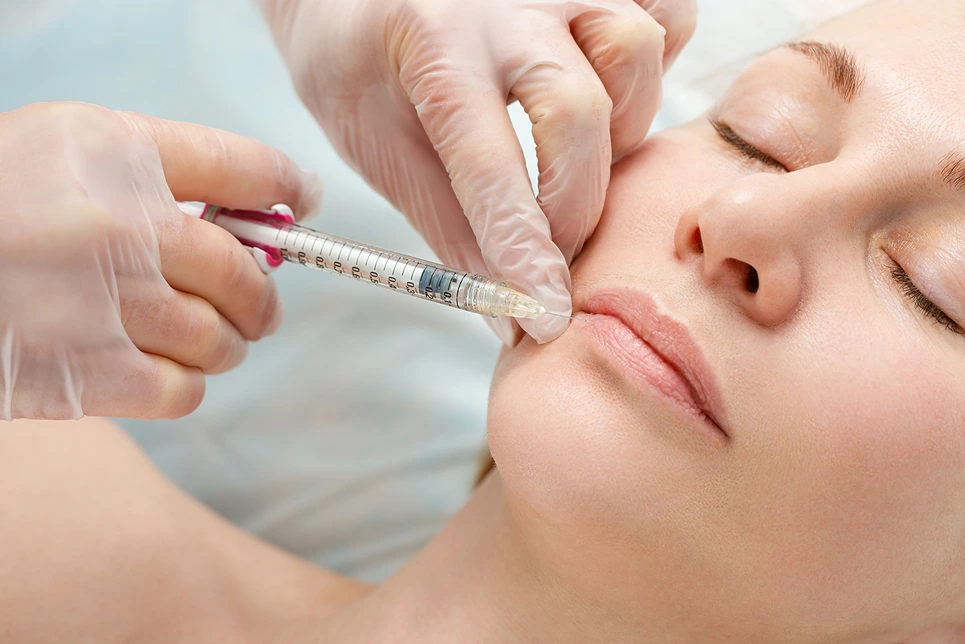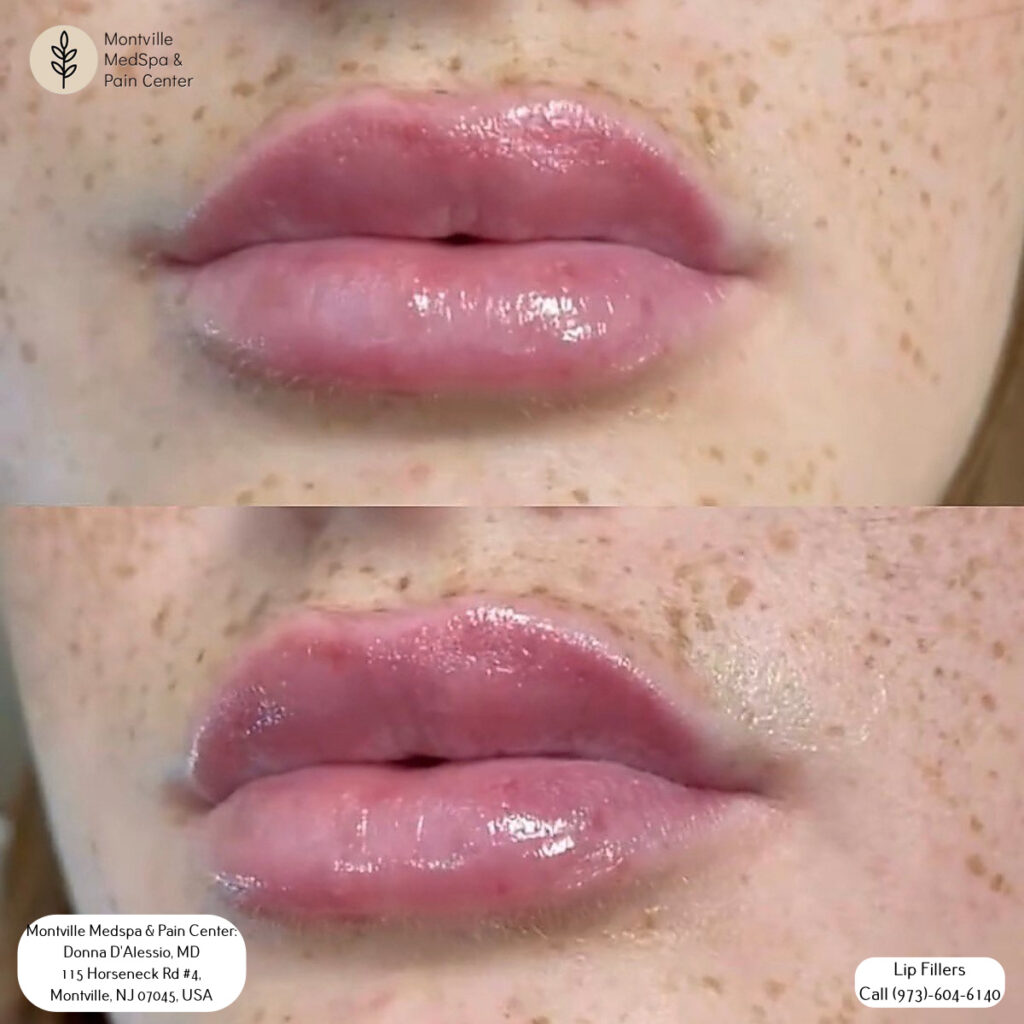Enhancing Lips from Every Angle
Lip fillers and lip injections are often used interchangeably, but they’re not exactly the same. Lip fillers typically refer to temporary dermal fillers, while lip injections can include fillers and other substances like Botox. Both procedures aim to enhance lip volume and shape, but it’s essential to consult a professional to understand the differences and determine the best option for you.
Luscious, plump lips are often viewed as a sign of youth and beauty. However, not everyone is naturally endowed with full, shapely lips. Fortunately, modern cosmetic treatments can give anyone the chance to enhance their lips.
What Are Lip Fillers and How Do They Enhance Your Lips?

Dermal fillers, also referred to as lip injections, use hyaluronic acid gel to add volume and definition to the lips. The filler substance is carefully injected in small amounts using an ultra-fine needle. This allows the injector to shape and contour the lips with great precision. The hyaluronic acid integrated into the tissues, adding youthful plumpness and structure.
Lip fillers can:
- Increase overall lip fullness
- Reshape uneven or asymmetric lips
- Define the vermilion border of the lips
- Add projection and definition to the cupid’s bow
- Reduce fine lines and wrinkles around the mouth
Lip fillers provide totally customizable enhancement based on each patient’s aesthetic goals. The minimally invasive injections usually take less than 30 minutes to complete.
Transform your lips into a stunning focal point with our expertly administered lip filler treatments at Montville MedSpa & Pain Center
ip Fillers vs. Lip Injections: Are They Different?
While the terms “lip fillers” and “lip injections” are often used interchangeably in cosmetic medicine, there is an important distinction between the two. Lip fillers specifically refer to injectable dermal fillers made of hyaluronic acid or other substances that temporarily add volume to the lips.
On the other hand, lip injections is a broader term that can include dermal fillers, as well as other injected substances like Botox.
Both lip fillers and certain lip injections utilize ultra-fine needles to inject filler substances into the lips, where the same materials can be used. However, the key difference lies in the fact that lip fillers provide temporary augmentation while other injectables like Botox relax the muscles around the lips.
It’s essential to consult a cosmetic professional to understand whether lip fillers or other types of lip injections will achieve your desired results. While the procedures may seem interchangeable, the substances injected can produce very different effects.
Understanding Lip Fillers: What Substances Are Used?
There are several types of filler materials that have been used for lip injections over the years. The ideal filler provides a natural-looking, smooth, soft volume that lasts a reasonable amount of time. The main categories of fillers used for the lips include:
Hyaluronic Acid (HA) Fillers
Hyaluronic acid is a glycosaminoglycan that naturally occurs in the human body, especially in the skin and connective tissues. When used as an injectable filler, hyaluronic acid provides volume and structure to the lips and restores lost soft tissue. The properties of hyaluronic acid make it an excellent choice for lip fillers – it is biocompatible, non-toxic, and does not require prior skin testing.
There are many brands of FDA-approved hyaluronic acid fillers on the market including Juvéderm, Restylane, and Belotero. These products contain hyaluronic acid formulations that have varied molecular weights and degrees of crosslinking, which affect the viscosity and duration of the fillers.
Collagen Fillers
Collagen is another common filler material derived from human cadaver skin, bovine tissue, or created synthetically. It was more extensively used in the past for lip augmentation. However, the potential for allergic reaction is higher with collagen fillers compared to hyaluronic acid. The effects also do not last as long. For these reasons, the use of collagen fillers have largely decreased.
Autologous Fat Transfer
With autologous fat transfer, fat is harvested from another area of the patient’s body via liposuction and then reinjected into the lips. The patient’s own fat cells can provide a natural look and feel. However, outcomes are less predictable compared to standardized injectable fillers. Absorption rates of the grafted fat tend to be high and some of the volume is usually lost over time. Multiple fat grafting sessions are often needed to maintain the desired effect.
How Is the Lip Filler Injection Procedure Performed?

Getting lip fillers takes just three simple steps:
- The injection site is cleaned and numbed using a topical anesthetic.
- The injector maps out the injection sites and carefully inserts the needle to deposit small amounts of filler in the desired locations.
- After the injections are complete, ice is applied to soothe any swelling and promote healing.
Patients may feel some minor discomfort from the injections. The whole process often takes 15-30 minutes depending on the number of injection sites. Nuanced techniques like fanning and crosshatching help create very natural-looking, smooth results.
Embark on your journey to plumper lips with our precise and comfortable lip filler procedure at Montville MedSpa & Pain Center
How Long Do the Effects of Lip Fillers Last?
On average, hyaluronic acid lip fillers provide noticeable enhancement for 6-12 months. However, there is significant variation among individuals. Factors like filler placement, amount injected, and rate of metabolism influence longevity.
Some patients may retain results for up to 2 years, while others see diminishing fullness in less than 6 months. Follow-up and touch-up appointments help maintain lip filler results.
Collagen fillers tend to break down faster than HA, requiring more frequent touch-ups. Fat grafting offers longer-lasting augmentation, but a portion of the transferred fat may be reabsorbed.
Advantages and Disadvantages of Lip Fillers
| Advantages | Potential Disadvantages |
| Non-surgical and minimally invasive | Temporary results requiring repeat treatments |
| Customizable results | Moderate discomfort during the injections |
| Quick treatment and no downtime afterward | Short-term swelling, bruising, or unevenness |
| Natural-looking outcomes | Risk of infection or injury from improperly placed injections |
| Reversible if patient is unsatisfied | Lumps or nodules may form under the skin in rare cases |
| Minimal risk of complications | |
| More affordable than surgical lip augmentation |
Hyaluronic acid lip fillers have an outstanding safety record and high levels of patient satisfaction. However, improper injection techniques can lead to poor outcomes and the need for reversal in some cases.
What Is the Recovery Process Like for Lip Fillers?
The recovery from lip filler injections is quick and comfortable for most patients. It is common to experience some tenderness, swelling, redness, and minor bruising at the injection sites. These typically resolve within a few days.
Patients can use oral pain relievers and apply ice packs as needed for relief. Avoiding strenuous exercise for 24 hours reduces swelling. Most people feel ready to return to work and normal activities immediately after their lip filler appointment.
Proper care right after the injections promotes the best possible results. Avoid manipulating or massaging the treated areas. Be gentle when brushing teeth, eating, and wearing lipstick until any swelling has subsided.
Should I Get Lip Fillers?

If your lips have lost volume or you’ve always wanted fuller lips, injectable dermal fillers are likely an excellent option. Consider lip fillers if you:
- Want to subtly enhance your natural lip shape
- Need to balance asymmetry in your lips
- Hope to restore a more youthful, plump lip contour
- Wish to soften vertical lip lines or smokers’ lines
- Seek quick, non-surgical augmentation with no downtime
Lip fillers should be avoided by anyone with a known allergy or sensitivity to hyaluronic acid products. It is also best to manage any oral herpes outbreaks prior to lip augmentation. Discuss your medical history fully at your consultation.
Consult with our skilled professionals to determine if lip fillers are the right choice for achieving your desired lip aesthetics at Montville MedSpa & Pain Center
FAQ
What is the cost of lip fillers on average?
The average cost of lip filler injections ranges from $500 to $2000 per syringe, depending on the provider, location, type of filler, and amount used.
How long does the numbness last after getting lip fillers?
Numbness and swelling after lip filler injections usually resolves within 2-4 hours. Some residual numbness may persist for up to 48 hours.
When will I see the final results after my lip fillers?
While some instant augmentation is visible, it takes 3-7 days for lip fillers to fully settle and integrate within the tissues. Final results are seen about 2 weeks post-treatment.
How old should you be to get lip fillers?
There is no specific age minimum, but lip fillers are only recommended for mature teenagers and adults. Individual factors are considered during the consultation.
Do lip fillers change the way your lips move?
When performed correctly, lip fillers should not affect the mobility or function of your lips. A skilled injector will preserve natural motion.
Getting Lip Fillers in Montville

Montville MedSpa & Pain Center offers expertly administered lip filler injections to enhance your natural beauty. Our experienced injectors carefully design each treatment to meet your specific goals. We use only FDA-approved dermal fillers for safe, precise results.
Visit our medspa in Montville today to learn more about lip fillers. We also offer great membership packages and special offers on injectable treatments. Contact us to schedule a free consultation and discuss your options for achieving luscious, gorgeous lips.










